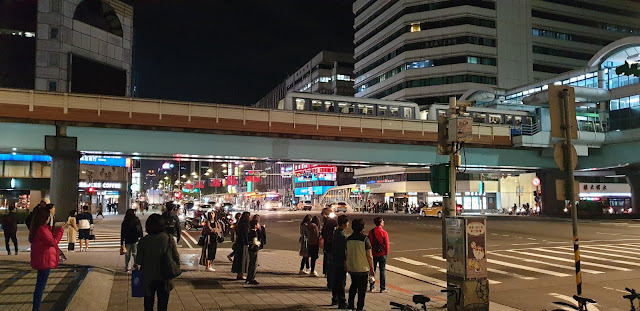About 43% of Taipei's residents uses public transport.[1] There is much Malaysia can learn from Taiwan if we want to hit 40% public transport usage by 2030.[2] All the more so for the state of Penang that is currently implementing the Penang Transport Master Plan (PTMP).
Last week, I get to check out Taiwan's various public transport systems such as inter-city buses, inter-state high speed rail, Kaohsiung's tram, Taichung's bus network, and Taipei's metro. Here are some observations.
Inter-city, inter-state network
Travellers who land at Taipei airport can get around Taiwan's northern region easily. There is a bus terminal attached to the airport with various bus companies providing connecting services from the airport directly to other cities and states.
Last week, I get to check out Taiwan's various public transport systems such as inter-city buses, inter-state high speed rail, Kaohsiung's tram, Taichung's bus network, and Taipei's metro. Here are some observations.
Inter-city, inter-state network
Travellers who land at Taipei airport can get around Taiwan's northern region easily. There is a bus terminal attached to the airport with various bus companies providing connecting services from the airport directly to other cities and states.
I took a two-hour bus from Taipei airport to Taichung, located in middle of Taiwan. I also took the high speed rail from Kaohsiung in the south to Taipei in the north. The inter-city and inter-state public transport infrastructure is excellent.
The upcoming Light Rail Transit (LRT) in Penang will serve the high-demand route from the airport to George Town, enhanced by feeder bus services to other parts of the state. Intercity transport services should be provided at the airport, where travellers who fly in can take buses to Taiping, Sungai Petani, Gurun and other towns in Perak and Kedah.
Urban public transport
Urban public transport
Kaohsiung's tram blends well into the port city which houses the famous Pier 2 art district. The tram's low-passenger capacity and slow speed allows for plenty sightseeing.
Taichung's and Taipei's public buses have exclusive lanes to maximise their speed on congested roads. Bus stations are located in the middle of the road to minimise traffic interruption.
Nonetheless, both the on-ground tram and bus have weakness and limitation when serving high-demand route. Their weakness is the high risk of collision with pedestrians, vehicles, and other road users.
In 2018, Taipei saw 466 bus accidents (27% increase from 2017) with various causes such as failure to note people or vehicle in front of the bus, driving negligence, violation of turning, violation of traffic light signal, and not yielding to pedestrians.[3]
The limitation of on-ground tram and bus is their inefficiency as they need to stop at junction and pedestrian crossing, delaying commuting time.
Elevated or underground rail system such as LRT and metro have much lesser risk of collision. Since they do not share road space with other users, these systems are more efficient compared to on-ground tram and bus. Kaoshiung and Taipei have built rail transit to serve busy routes, complemented by tram and bus respectively. The rail transit acts as the backbone of the public transport system.
Lobbying for a single tram or bus system to serve high-demand route makes no sense. Penang Forum's demand to replace the LRT plan with tram and bus will only expose commuters to high risk of collision and short-change Penangites with an inefficient public transport system.[4]
Instead of wasting time with Penang Forum's nonsense, we should listen to the evaluation by Universiti Sains Malaysia's deputy vice chancellor and professor of transportation engineering, Dr Ahmad Farhan Mohd Sadullah: "This is why I believe having an urban rail system is imperative and urgently needed for Penang. Rail is on the highest hierarchy of public transport. Only rail will have a chance of changing the fate of public transport and provide a better option towards a demand and supply equilibrium situation."[5]
There is much for us to learn from real expert and real examples from Taiwan cities to improve our local public transport infrastructure.
References
[1] https://international.thenewslens.com/article/92882
[2]https://www.intelligenttransport.com/transport-news/90793/new-policy-looks-to-double-public-transport-usage-in-malaysia-by-2030/
[3]https://www-ws.gov.taipei/Download.ashx?u=LzAwMS9VcGxvYWQvMzkxL3JlbGZpbGUvMTk3OTAvMzMyODM3NS81MjM1NDhiYi1lOGQ0LTQwNDEtYTg3ZC00NWU0OTM5MTI3MmIucGRm&n=eTA3LnBkZg%3d%3d&icon=.pdf
[4]https://www.malaymail.com/news/what-you-think/2019/12/28/penang-bayan-lepas-lrt-moving-people-or-moving-goalposts-khoo-salma-nasutio/1822834
[5] https://www.nst.com.my/news/nation/2019/09/521306/transforming-penangs-transport-system
References
[1] https://international.thenewslens.com/article/92882
[2]https://www.intelligenttransport.com/transport-news/90793/new-policy-looks-to-double-public-transport-usage-in-malaysia-by-2030/
[3]https://www-ws.gov.taipei/Download.ashx?u=LzAwMS9VcGxvYWQvMzkxL3JlbGZpbGUvMTk3OTAvMzMyODM3NS81MjM1NDhiYi1lOGQ0LTQwNDEtYTg3ZC00NWU0OTM5MTI3MmIucGRm&n=eTA3LnBkZg%3d%3d&icon=.pdf
[4]https://www.malaymail.com/news/what-you-think/2019/12/28/penang-bayan-lepas-lrt-moving-people-or-moving-goalposts-khoo-salma-nasutio/1822834
[5] https://www.nst.com.my/news/nation/2019/09/521306/transforming-penangs-transport-system
